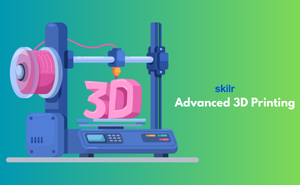👇 CELEBRATE CLOUD SECURITY DAY 👇
00
HOURS
00
MINUTES
00
SECONDS

Advanced 3D Printing refers to the process of building physical objects from digital blueprints through a layer-by-layer approach. Instead of using conventional methods like carving or molding, this technology creates items directly from materials such as plastic, resin, or metal. This makes it possible to design intricate shapes, speed up production, and reduce waste compared to older manufacturing techniques.
The Advanced 3D Printing Certification is designed to train learners on specialized methods, material selection, design for 3D printing, and large-scale industry use cases. With this knowledge, candidates can push the limits of design and innovation, applying 3D printing to advanced industries including medical devices, aerospace engineering, automotive manufacturing, and consumer product development.
This exam is ideal for:
Industry-endorsed certificates to strengthen your career profile.
Start learning immediately with digital materials, no delays.
Practice until you’re fully confident, at no additional charge.
Study anytime, anywhere, on laptop, tablet, or smartphone.
Courses and practice exams developed by qualified professionals.
Support available round the clock whenever you need help.
Easy-to-follow content with practice exams and assessments.
Join a global community of professionals advancing their skills.
Absolutely, it’s a great tool for prototyping and creating innovative products.
It combines both—technical skills with creative applications.
It allows for faster, customized, and cost-efficient production.
It’s for engineers, designers, healthcare professionals, and innovators interested in advanced manufacturing.
Basic understanding helps, but the certification explains advanced concepts step by step.
Aerospace, automotive, healthcare, construction, and consumer products.
Yes, it helps them create prototypes and even explore large-scale 3D construction.
No, it covers metals, composites, ceramics, and biocompatible materials too.
Yes, CAD and design optimization are important parts of the program.
It enables the creation of custom prosthetics, implants, and medical models.